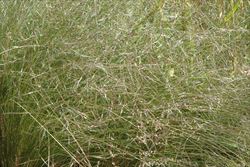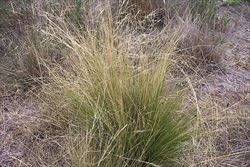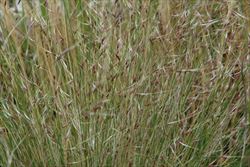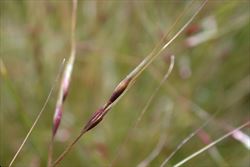Click on images to enlarge

habit (Photo: Rob and Fiona Richardson)

habit in flower (Photo: Rob and Fiona Richardson)

habit with trailing seed-heads and leaves (Photo: Jackie Miles and Max Campbell)

habit during the dry season (Photo: Jackie Miles and Max Campbell)

close-up of stem and leaves (Photo: Jackie Miles and Max Campbell)

seed-heads (Photo: Rob and Fiona Richardson)

flower spikelets (Photo: Rob and Fiona Richardson)

close-up of flower spikelets (Photo: Rob and Fiona Richardson)

close-up of seeds (Photo: Steve Hurst at USDA PLANTS Database)
Scientific Name
Nassella trichotoma (Nees) Hack. ex Arechav.
Synonyms
Stipa trichotoma Nees
Family
Gramineae (South Australia)Poaceae (Queensland, New South Wales, the ACT, Victoria, Tasmania, Western Australia and the Northern Territory)
Common Names
nassella tussock, serrated tussock, Yass River tussock, Yass tussock
Origin
Native to southern South America (i.e. southern Brazil, Argentina, Chile, Peru and Uruguay).
Naturalised Distribution
Widely naturalised in south-eastern Australia (i.e. in eastern New South Wales, the ACT, many parts of Victoria and in Tasmania).
Habitat
A weed of temperate and semi-arid regions. It commonly grows in pastures, grasslands, open woodlands and drier forests (particularly in highland areas). Also found along roadsides, in disturbed sites and in waste areas.
Habit
A long-lived (i.e. perennial) tussock-forming grass usually growing 20-70 cm tall.
Distinguishing Features
- a tussock-forming, long-lived grass with very fine and highly inrolled leaves (less than 0.5 mm wide).
- the margins of these leaves are very finely toothed, hence the common name 'serrated tussock'.
- stems and leaves are upright at first (20-70 cm tall), but become drooping or trailing in nature as they age.
- the seed-head is an open branched panicle (8-25 cm long) with many flower spikelets that are borne singly.
- these flower spikelets are elongated in shape (4-9 mm long) and topped with an awn (15-35 mm long).
- the mature 'seed' has an obscure ring of tiny hairs where the bent and twisted awn attaches to the top of the seed.
Stems and Leaves
The flowering stems (i.e. culms) are much branched and drooping at maturity.
Large numbers of thin, wiry leaves (15-50 cm long) are produced by each tussock, mostly near the base of the plant. These leaves (only 0.2-0.6 mm wide) are very thin (i.e. filiform) and very tightly rolled (i.e. convoluted), giving them a cylindrical (i.e. terete) appearance. Leaf sheaths and blades are mostly hairless (i.e. glabrous) with very fine teeth along their margins. Where the leaf sheath meets the leaf blade there is a small membranous structure (i.e. ligule) that is 0.5-2.5 mm long, but is usually less than 1 mm long.
Flowers and Fruit
The seed-head is a branched open panicle usually 8-25 cm long, but occasionally reaches up to 40 cm in length. The inconspicuous flower spikelets are borne singly at the tips of the seed-head branches, and each flower spikelet contains a single tiny flower (i.e. floret) and two bracts (i.e. glumes). These flower spikelets (4-9 mm long) are elongated and cylindrical (i.e. lanceolate and terete) in shape and topped with a long awn. Flowering occurs mostly during late spring and summer.
When mature the 'seed' separates from the bracts (i.e. glumes), which remain on the seed-head branches for some time afterwards. The mature 'seed' has a sharpened, hairy tip (i.e. pilose callus) at one end and a twisted, bent awn (15-35 mm long) at the other end. Where the awn attaches to the seed there is an obscure collar-like ring of tiny hairs (i.e. coma). Hidden within the hard-coated 'seed', which consists of two reddish-brown or purple coloured bracts (i.e. the palea and lemma), is the small (1.2-2 mm long) dark brown-coloured, and oblong-shaped grain.
Reproduction and Dispersal
This species reproduces via seed. These seeds are most commonly spread by wind and also become attached to animals, clothing and vehicles. They may also be dispersed in contaminated agricultural produce (e.g. fodder) and soil.
Environmental Impact
Serrated tussock (Nassella trichotoma) is one of the Weeds of National Significance (WoNS) in Australia, and is regarded as an environmental weed in Victoria, New South Wales, the ACT and Tasmania.
Legislation
This species is declared under legislation in the following states and territories:
- ACT: C3 - a pest plant that must be contained and C4 - prohibited - a pest plant whose supply is prohibited in the ACT.
- New South Wales: Class 3 - a regionally controlled weed. The relevant local control authority must be promptly notified of the presence of this weed and it must be fully and continuously suppressed and destroyed (in a minority of local authority areas). Class 4 - a locally controlled weed. The growth and spread of this species must be controlled according to the measures specified in a management plan published by the local control authority and the plant may not be sold, propagated or knowingly distributed (in a majority of local authority areas). See the New South Wales Department of Primary Industries Noxious Weeds List at http://www.dpi.nsw.gov.au for more detailed information on which local areas are covered in these declarations.
- Northern Territory: A - to be eradicated (throughout the Territory) and C - not to be introduced into the Territory.
- Queensland: Class 1 - introduction into the state is prohibited, and landowners must take reasonable steps to keep land free of this species (throughout the entire state). It is also illegal to sell a declared plant or its seed in this state.
- South Australia: 1@ - this species is declared under Class 1c(i), a classification for prohibited terrestrial plants. Its presence must be notified and the plant must be destroyed (throughout the entire state).
- Tasmania: D - the importation or sale of this species is prohibited and measures to reduce its population in an area, eradicate it from an area, or restrict it to a particular area may be required.
- Victoria: P6 - prohibited and must be eradicated or controlled (in the Mallee, North Central, Corangamite, Goulburn, North East and East Gippsland regions), and C4 - all reasonable steps must be taken to control the weed and prevent its spread (in the Glenelg, Port Phillip West, Port Phillip East and West Gippsland regions).
- Western Australia: Prohibited - on the prohibited species list and not permitted entry into the state.
Management
For information on the management of this species see the following resources:
- the National Weeds Strategy Strategic Plan for this species, which is available online at http://www.weeds.org.au/docs/ststrat.pdf.
- the Victorian Department of Primary Industries Landcare Note on this species, which is available online at http://www.dpi.vic.gov.au.
- the New South Wales Department of Primary Industries Agfact on this species, which is available online at http://www.dpi.nsw.gov.au.
- the Tasmanian Department of Primary Industries and Water weed service sheet on this species, which is available online at http://www.dpiw.tas.gov.au.
Similar Species
Serrated tussock (Nassella trichotoma) is very similar to Mexican feathergrass (Nassella tenuissima) and these two species can usually only be distinguished when in flower. They have the following differences:
- serrated tussock (Nassella trichotoma) seeds have a relatively small awn (15-35 mm long).
- Mexican feathergrass (Nassella tenuissima ) seeds have a very large awn (50-90 mm long).
Serrated tussock (Nassella trichotoma) is also relatively similar to Chilean needlegrass (Nassella neesiana), lobed needlegrass (Nassella charruana), cane needlegrass (Nassella hyalina), Texas needlegrass (Nassella leucotricha) and short-spined needlegrass (Nassella megapotamia). However, these grasses generally have wider leaves (usually 1-5 mm wide) and have a membranous crown-like structure (i.e. corona) where the awn meets the top of the seed. Also, some of these species (i.e. Nassella neesiana, Nassella hyalina and Nassella leucotricha) produce stem seeds (i.e. cleistogenes).
In addition, several native tussock-forming grasses can look similar (e.g. Poa spp. and Austrostipa spp.). However, these species either lack ligules on their leaves or have ligules that are fringed with hairs.
Note: This page only covers those grasses that are commonly confused with this species. For a more in-depth key to all of the grasses present in Australia, see the AusGrass: Grasses of Australia CD-ROM or Flora of Australia, Volumes 43 and 44.

